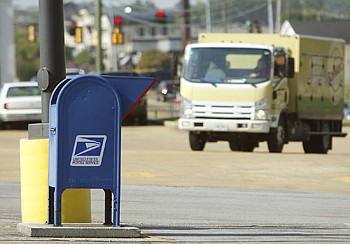Steve Combs slid an envelope into a U.S. Postal Service blue collection box on Browns Ferry Road and then reminisced about the days when the boxes were more plentiful in the Chattanooga area.
Despite e-mail, text messaging and the Internet, the Trenton, Ga., resident still uses the traditional boxes at least once a week on his way home from work.
"It used to be convenient just about anywhere in Chattanooga just to drop a letter off," he said. "Now it's becoming more like you almost have to go to a post office because these things are not available."
BY THE NUMBERS374 ZIP codes (Chattanooga)* 147 boxes remaining* 110 removed during 2008-10373 ZIP codes (18 counties in Southeast Tennessee)* 150 boxes remaining* 20 removed during 2009-10307 ZIP codes (7 counties in Northwest Georgia)* 82 boxes remaining* 18 removed during 2009-10Source: U.S. Postal Service, newspaper archives
Combs' observations are reflected in Postal Service figures, which show a decline in the number of boxes in Southeast Tennessee and Northwest Georgia.
"The old, familiar blue mail collection boxes, they're just no longer the primary way that people mail today," said Beth Barnett, Tennessee spokeswoman for the Postal Service. "In recognition of that, we have made some changes."
The 374 ZIP code area - basically everything within Chattanooga's city limits - once had as many as 652 boxes, and now only 147 remain.
Since 2008 alone, 110 boxes have been removed from the Scenic City, records show.
Barnett said the Postal Service does periodic "density studies" to see how much each box is used. Boxes that don't average 25 pieces of mail a day are moved to a potentially better spot or decommissioned.
"We look at usage, just like any business would," she said. "That is one way we can be as efficient as possible."
The 373 ZIP code area - 18 counties that stretch from Monroe in the east to Lincoln in the west plus Hamilton County outside Chattanooga - has lost 20 boxes since 2009, leaving 150.
Region leaders said residents have not lodged any recent complaints.
"I haven't heard a word at all about it in the community," Franklin County Mayor Richard Steward said.
Bradley County Mayor D. Gary Davis said several people got angry in 2008 when construction forced a couple of boxes near the county's courthouse to be moved a block away.
"[Those boxes] are still there, so I haven't heard any talk about blue boxes in a while," he said.
In the 307 ZIP code area, a seven-county region in Northwest Georgia, the number of boxes has fallen from 100 in the beginning of 2009 to 82.
"I have no complaints myself, nor have I heard any," said Bill Clark, Catoosa County Commission chairman.
TECHNOLOGY, ECONOMY FORCE CHANGE
The decline in blue box usage is a "small portion" of "unprecedented losses" the Postal Service has seen in the past four years, Barnett said.
Consultants expect the Postal Service cumulatively to lose anywhere between $115 billion and $238 billion over the next 10 years. The company blames a slumping economy and the Internet, which allows people to mail in a matter of seconds.
"If I remember correctly, e-mail's fastest-growing segment is [older generations], so who is still writing letters?" asked Elizabeth Gailey, a communications professor at the University of Tennessee at Chattanooga.
In 2006, the record-setting year for mail volume, 213 billion items were delivered by the Postal Service, the nation's second-largest civilian employer. That total included packages, advertisements, letters and everything else that can be mailed.
By 2009, volume dropped 17 percent to 177 billion pieces. Consultants predict volume will drop to 150 billion by 2020.
Paul Kleindorfer, who since 1990 has co-organized the international Conference on Postal Delivery and Economics, said the United States isn't the only country with drops in mail volume.
"Anywhere you look, you would find a similar story," he said. "These declines are worldwide, and they are the result of e-substitution [people mailing on the web]."
Kleindorfer said there is "no expected recovery" for "traditional mail products."
"[Postage numbers are] going to decline - hopefully gracefully," he added.
LOOKING TO THE FUTURE
Other countries have turned to "product diversification" and "hybrid mail products" to combat mail volume declines, Kleindorfer said.
One example of diversification is using postal facilities for both postage and banking, he said. An example of a hybrid product, he explained, is a company scanning mail onto a computer and e-mailing it to customers, while only delivering hard copies on certain days of the week and only upon request.
The Postal Service is looking into new technologies, Barnett said, but it's also examining nontechnical methods.
She said the Postal Regulatory Commission is expected to decide by October whether to drop Saturday mail delivery, saving up to $40 billion a year.
Other possible cost-savers mentioned by Barnett are across-the-board consolidations at post office branches and administrative offices, and the elimination of "redundant operations" in delivery methods.
"It's just a changing time," she said, "and we're trying to do all the right things to be leaner and better able to respond and take care of business."
In spite of cost-saving efforts, none of the several hundred post offices, including four in Chattanooga, that were up for possible closure in 2009 were shut down, Barnett said.
Many residents objected when the Chattanooga branch offices - Highland Park, Murray/Lake Hills, East Lake and North Chattanooga - were on the cutting block.
"There was an outcry because there still is a feeling of community around post offices," Gailey said. "I think people want that small-town, face-to-face interaction."
